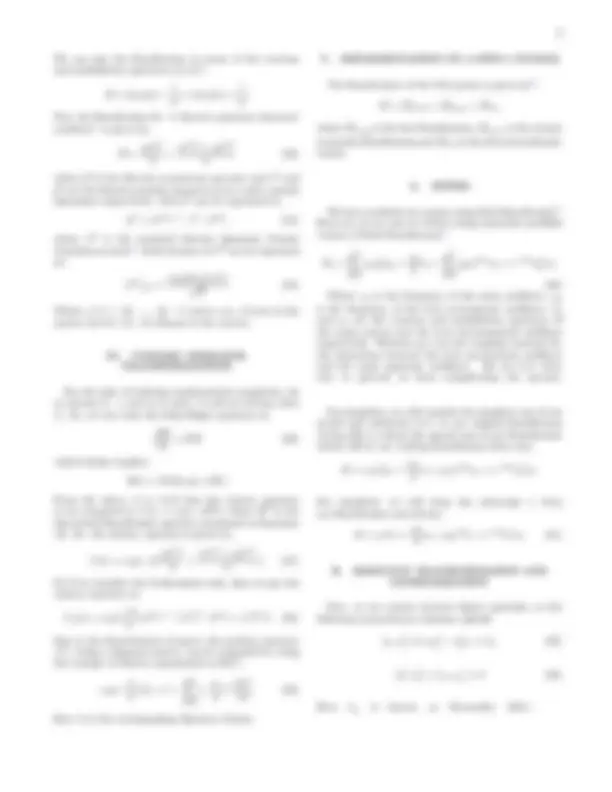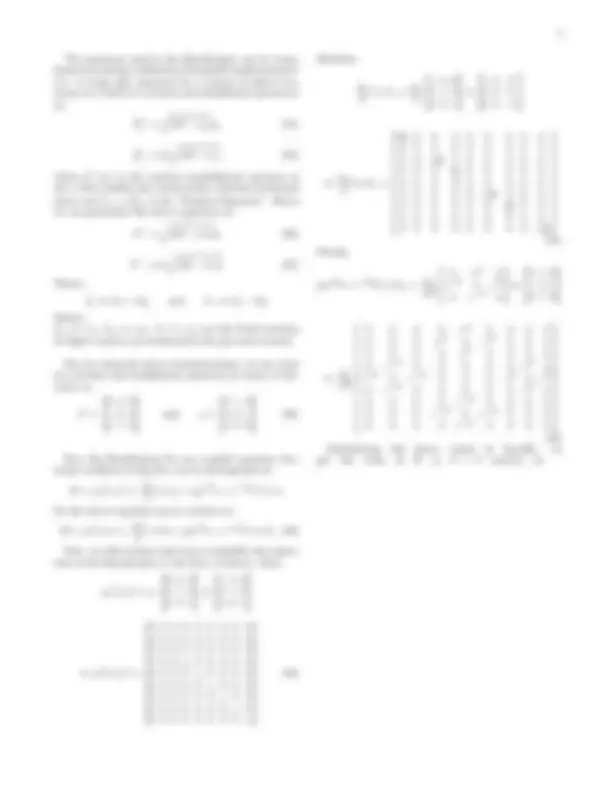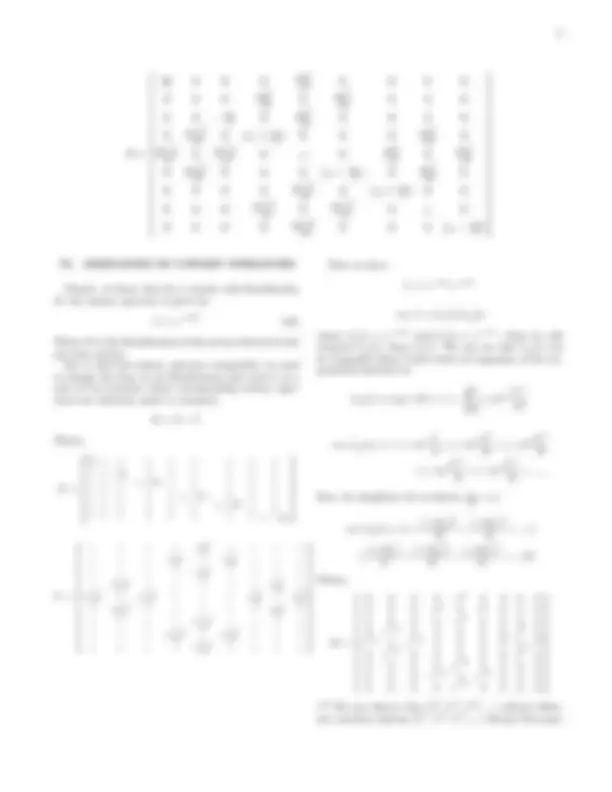






Study with the several resources on Docsity

Earn points by helping other students or get them with a premium plan


Prepare for your exams
Study with the several resources on Docsity

Earn points to download
Earn points by helping other students or get them with a premium plan
Community
Ask the community for help and clear up your study doubts
Discover the best universities in your country according to Docsity users
Free resources
Download our free guides on studying techniques, anxiety management strategies, and thesis advice from Docsity tutors
The process of deriving the unitary operators for Spin-1 particles using Pauli Matrices equivalents. the mathematical modeling of the equivalent matrices, the transformation of unitary operators, and the implementation of the Spin-1 system into the Quantum Harmonic Oscillator. The document also provides the Hamiltonian of the system and the relevant transformations and generalizations.
Typology: Slides
1 / 8

This page cannot be seen from the preview
Don't miss anything!





Rajdeep Tah
1, ∗
1 School of Physical Sciences,
National Institute of Science Education and Research Bhubaneswar, HBNI, Jatni, P.O.-752050, Odisha, India
(Dated: July, 2020)
Here, we derive the Pauli Matrix Equivalent for Spin-1 particles (mainly Z-Boson and W-Boson).
Pauli Matrices are generally associated with Spin-
1 2 particles and it is used for determining the
properties of many Spin-
1 2 particles. But in our case, we try to expand its domain and attempt to
implement it for calculating the Unitary Operators of the Harmonic oscillator involving the Spin-
system and study it.
I. INTRODUCTION
Pauli Matrices are a set of three 2 × 2 complex matri-
ces which are Hermitian and Unitary in nature and they
occur in the Pauli Equation which takes into account
the interaction of the spin of a particle with an exter-
nal electromagnetic field. In Quantum Mechanics, each
Pauli matrix is related to an angular momentum opera-
tor that corresponds to an observable describing the spin
of a Spin-
1 2 particle, in each of the three spatial direc-
tions. But we seldom need to deal with particles which
are having spin more than 1 2
i.e. Spin-1 Particles; Spin- 3 2
Particles; Spin-2 Particles; etc. and for that we need
to search for matrices which perform similar function to
that of Pauli Matrices (in case of Spin-
1 2
particles). In
Spin-
1 2
particles, the Pauli Matrices are in the form of:
X = σx =
Y = σy =
0 −i
i 0
Z = σz =
Also sometimes the Identity Matrix, I is referred to
as the ‘Zeroth’ Pauli Matrix and is denoted by σ 0.
The above denoted Matrices are useful for Spin-
1 2
particles like Fermions (Proton, Neutrons, Electrons,
Quarks, etc.) and not for other particles. So, in this
paper we will see how to further calculate the equiv-
alent Pauli Matrix for Spin-1 particles and implement
it to calculate the Unitary Operators of the Quan-
tum Harmonic Oscillator involving a Spin-1 system.
S tructure:
In Section II, we do the Mathematical Modelling
for the Equivalent Matrices and discuss the results for
higher spin particles. Then, in Section III we revisit the
harmonic oscillator in-context of our quantum world and
discuss its analytical solution along with its features.
In Section IV, we involve with the transformation of
Unitary Operators and after that in Section V, we
involve the implementation of the Spin-1 system into
the Quantum Harmonic Oscillator with relevant trans-
formations and generalization which ultimately leads to
the derivation of the Hamiltonian of our system. Then
in Section VI, we derive the Unitary Operators of our
system using the informations from the previous sections
and then in its following subsection we represent the
16 × 16 Matrix of the different Unitary Operators. At
last, in Section VII, we discuss the Results of our project
followed by the Conclusion and Acknowledgement.
II. MATHEMATICAL MODELLING
Let us assume that we have a Spin-s system for which
the Eigenvalue S
2 is given by:
2 = s(s + 1)ℏ
2 (4)
Or
s(s + 1)ℏ
The eigenvalues of Sz are written sz ℏ , where sz is al-
lowed to take the values s, s − 1 , · · · , −s + 1, −s i.e. there
are 2s + 1 distinct allowed values of sz. We can repre-
sent the state of the particle by (2s + 1) different Wave-
functions which are in-turn denoted as ψsz (x
′ ). Here
ψs z (x ′ ) is the Probability density for observing the parti-
cle at position x
′ with spin angular momentum sz ℏ in the
z- direction. Now, by using the extended Pauli scheme,
we can easily find out the Momentum operators and the
Spin operators. The Spin Operator comes out in the
form:
(σk)jl =
〈s, j|Sk|s, l〉
sℏ
Where, j and l are integers and j, l ∈ (−s, +s).
Now, to make our calculations easier, we continue with
σz matrix. We know that:
Sz |s, j〉 = jℏ|s, j〉 (6)
∴ We can write:
(σ 3 )jl =
〈s, j|Sk|s, l〉
sℏ
j
s
δij (7)
Here we have used the Orthonormality property of |s, j〉.
Thus, σz is the suitably normalized diagonal matrix of
the eigenvalues of Sz. The elements of σx and σy are
most easily obtained by considering the ladder operators:
S± = Sx ± iSy (8)
Now, according to Eq.(5)-(8), we can write
9 :
S+ |s, j〉 = [s (s + 1) − j (j + 1)]
1 / 2 ℏ |s, j + 1〉 (9)
and
− |s, j〉 = [s (s + 1) − j (j − 1)]
1 / 2 ℏ |s, j − 1 〉. (10)
Now, by combining all the conditions and equations, we
have:
(σ 1 )j l =
[s (s + 1) − j (j − 1)]
1 / 2
2 s
δj l+
[s (s + 1) − j (j + 1)]
1 / 2
2 s
δj l− 1
and
(σ 2 )j l =
[s (s + 1) − j (j − 1)]
1 / 2
2 i s
δj l+
[s (s + 1) − j (j + 1)] 1 / 2
2 i s
δj l− 1
∴ According to Eq.(7), Eq.(11) and Eq.(12), we have:
σ 1 =
σ 2 =
0 −i 0
i 0 −i
0 i 0
σ 3 =
Where, σ 1 , σ 2 , σ 3 are the Pauli Matrix equivalents for
Spin-1 Particles.
III. HARMONIC OSCILLATOR IN BRIEF
The most common and familiar version of
the Hamiltonian of the quantum harmonic
oscillator in general can be written as:
pˆ
2
2 m
mω
2 xˆ
pˆ
2
2 m
kˆx
2 (16)
where Hˆ is the Hamiltonian of the System, m is
the mass of the particle, k is the bond stiffness
(which is analogous to spring constant in clas-
sical mechanics), xˆ is the position operator and
pˆ = −iℏ
∂x
is the momentum operator where ℏ
is the reduced Plank’s constant.
The analytical solution of the Schrodinger
wave equation is given by Ref.
1 :
∞ ∑
nx=
∞ ∑
ny =
2 n^ n!
mω
πℏ
e
−
ζ^2 (^2) e−^
β^2 (^2) H nx (ζ)Hny (β)U^ (t)
Where;
ζ =
mω
x and β =
mω
y (19)
Here Hn is the nth order Hermite polynomial. U(t) is the
unitary operator of the system showing its time evolution
and is given by:
U (t) = exp(
−itEn
) = e
−itEn ℏ (^) (20)
where En are the allowed energy eigenvalues of the par-
ticle and are given by:
En = (nx +
)ℏω + (ny +
)ℏω = (nx + ny + 1)ℏω (21)
And the states corresponding to the various energy
eigenvalues are orthogonal to each other and satisfy:
−∞
ψj ψxdxi = 0 : ∀ xi (22)
A much simpler approach to the harmonic oscil-
lator problem lies in the use of ladder opera-
tor method where we make use of ladder oper-
ators i.e. the creation and annihilation opera-
tors (ˆa, ˆa†), to find the solution of the problem.
** Here ˆa† denotes the ‘Creation’ operator and ˆa
denotes the ‘Annihilation’ operator in Spin-1 system.
The operators used in the Hamiltonian can be trans-
formed according to Holstein-Primakoff transformations 8
(i.e. it maps spin operators for a system of spin-S mo-
ments on a lattice to creation and annihilation operators)
as:
j
(2S − ˆnj )ˆaj (34)
− j = ˆa
† j
(2S − nˆj ) (35)
where ˆa
† j (ˆaj ) is the creation (annihilation) operator at
site j that satisfies the commutation relations mentioned
above and ˆnj = ˆa
† j ˆa j is the “Number Operator”. Hence
we can generalize the above equations as:
=
(2S − a † a)a (36)
− = a
†
(2S − a † a) (37)
Where;
S+ ≡ Sx + iSy and S− ≡ Sx − iSy
Where;
Sx (= σ 1 ), Sy (= σ 2 ), Sz (= σ 3 ) are the Pauli matrices
for Spin-1 system (as mentioned in the previous section).
Now by using the above transformations; we can write
our creation and annihilation operators in terms of Ma-
trices as:
a
(^) and a =
Now the Hamiltonian for our coupled quantum har-
monic oscillator in Eq.(31) can be decomposed as:
H = ωa
† a ⊗ I +
ω 0
I ⊗ σ 3 + g(e
iθ a + e
−iθ a
† ) ⊗ σ 1
Or the above equation can be written as:
H = ωa
† a ⊗ I +
ω 0
I ⊗ S 3 + g(e
iθ a + e
−iθ a
† ) ⊗ S 1 (39)
Now, we will evaluate each term to simplify the expres-
sion of the Hamiltonian in the form of matrix. Here,
ωa
† a ⊗ I = ω
⇒ ωa
† a ⊗ I =
0 0 0 ω 0 0 0 0 0
0 0 0 0 ω 0 0 0 0
0 0 0 0 0 ω 0 0 0
0 0 0 0 0 0 ω 0 0
0 0 0 0 0 0 0 ω 0
0 0 0 0 0 0 0 0 ω
Similarly,
ω 0
I ⊗ Sz =
ω 0
ω 0
I ⊗ Sz =
ω 0 2
ω 0 2
ω 0 2
ω 0 2
ω 0 2
ω 0 2
Finally,
g(e
iθ b + e
−iθ b
† ) ⊗ Sx =
g √ 2
0 e iθ 0
e
−iθ 0 e
iθ
0 e
−iθ 0
g √ 2
0 0 0 0 e iθ 0 0 0 0
0 0 0 e
iθ 0 e
iθ 0 0 0
0 0 0 0 e
iθ 0 0 0 0
0 e
−iθ 0 0 0 0 0 e
iθ 0
e
−iθ 0 e
−iθ 0 0 0 e
iθ 0 e
iθ
0 e
−iθ 0 0 0 0 0 e
iθ 0
0 0 0 0 e
−iθ 0 0 0 0
0 0 0 e −iθ 0 e −iθ 0 0 0
0 0 0 0 e −iθ 0 0 0 0
Substituting the above values in Eq.(39), we
get the value of H (a 9 × 9 matrix) as:
ω 0 2
geiθ √ 2
ge iθ √ 2
ge iθ √ 2
ω 0 2
ge iθ √ 2
ge −iθ √ 2
ω 0 2
ge iθ √ 2
ge−iθ √ 2
ge−iθ √ 2
geiθ √ 2
geiθ √ 2
ge −iθ √ 2
ω 0 2
ge iθ √ 2
ge −iθ √ 2
ω 0 2
ge −iθ √ 2
ge −iθ √ 2
ge −iθ √ 2
ω 0 2
VI. DERIVATION OF UNITARY OPERATORS
Clearly, we know that for a system with Hamiltonian
H, the unitary operator is given by:
U = e
−iHt (43)
Where H is the Hamiltonian of the system derived in the
previous section.
But to find the unitary operator compatible, we need
to change the form of our Hamiltonian and write it as a
sum of two matrices whose corresponding unitary oper-
ators are relatively easier to compute:
Where,
ω 0 2 0 0 0 0 0 0 0 0 0 0 0 0 0 0 0 0 0 0 0 − ω 0 2 0 0 0 0 0 0 0 0 0 (ω + ω 0 2 )^0 0 0 0 0 0 0 0 ω 0 0 0 0 0 0 0 0 0 (ω − ω 0 2 )^0 0 0 0 0 0 0 0 (ω + ω 0 2 )^0 0 0 0 0 0 0 0 ω 0 0 0 0 0 0 0 0 0 (ω − ω 0 2 )
0 0 0 0 ge
iθ √ 2
0 0 0 0
0 0 0 ge √iθ 2 0 ge √iθ 2 0 0 0
0 0 0 0 geiθ √ 2
0 0 0 0
0 ge
−iθ √ 2
0 0 0 0 0 ge
iθ √ 2
0
ge−iθ √ 2
0 ge−iθ √ 2
0 0 0 geiθ √ 2
0 geiθ √ 2 0 ge
−iθ √ 2
0 0 0 0 0 ge
iθ √ 2
0
0 0 0 0 ge √−iθ 2 0 0 0 0
0 0 0 ge
−iθ √ 2
0 ge
−iθ √ 2
0 0 0
0 0 0 0 ge √−iθ 2 0 0 0 0
Thus we have,
U = e
−iXt .e
−iY t
=⇒ U = Ux(t).Uy (t)
where Ux(t) = e
−iXt and Uy (t) = e
−iY t
. First we will
compute Uy (t), then Ux(t). We can see that Uy (t) can
be expanded using Taylor series of expansion of the ex-
ponential function as:
Uy (t) = exp(−itY ) = I +
∞ ∑
m=
(−it)
m
m
m!
=⇒ Uy (t) = I + (−it)
2
3
+(−it)
4
4
5
5
Now, for simplicity, let us denote
g √ 2
= g
′
=⇒ Uy (t) = [1 +
(−itg
′ ) 2
(−itg
′ ) 4
(−itg
′ )
(−itg
′ ) 3
(−itg
′ ) 5
Where;
0 0 0 0 e iθ 0 0 0 0
0 0 0 e iθ 0 e iθ 0 0 0
0 0 0 0 e
iθ 0 0 0 0
0 e
−iθ 0 0 0 0 0 e
iθ 0
e
−iθ 0 e
−iθ 0 0 0 e
iθ 0 e
iθ
0 e
−iθ 0 0 0 0 0 e
iθ 0
0 0 0 0 e
−iθ 0 0 0 0
0 0 0 e
−iθ 0 e
−iθ 0 0 0
0 0 0 0 e
−iθ 0 0 0 0
(** We can observe that [Y
2 , Y
4 , Y
6 ,....] will give Iden-
tity matrices whereas [Y
1 , Y
3 , Y
5 ,...] will give the same
UNITARY OPERATOR MATRIX
REPRESENTATIONS
The 16 × 16 Matrix representation of the Unitary op-
erators Uy (t) and Ux(t) are:
Uy (t) =
Where,
A = cos(
gt √ 2
); B = −i sin(
gt √ 2
)e iθ and C = −i sin(
gt √ 2
)e −iθ .
Ux(t) =
1 S
Where,
P = e
−(ω+
ω 0 2 )it ; Q = e
(−ω)it ; R = e
−(ω−
ω 0 2 )it ;
S = e (−
ω 0 2 )it^ and 1 s
1
e (− ω 0 2 )it^
= e (
ω 0 2 )it
DATA AVAILABILITY
Further information regarding process of implementing
the Unitary Operators on higher spin particles like Spin- 3 2
particles, Spin-2 particles etc. can be made available
upon reasonable number of requests.
VII. RESULTS
In first part of our paper, we extend the idea
of Pauli Matrices from Spin-
1 2
particles to Spin-
particles and see the implementation of the equiv-
alent matrices. We can also see that equivalent
Pauli Matrices can also be found for higher spin
particles like Spin-
3 2 particles, Spin-2 particles etc.
In the final part, we introduce a coupled quantum
harmonic oscillator to a Spin-1 system (Z-Bosonic/ W-
Bosonic system etc.) and try to implement its unitary op-
erator to the system using our previous section’s knowl-
edge.
CONCLUSION
Now, we understand that we can further implement
the idea of Pauli equivalent matrices on higher spin par-
ticles and derive the unitary operators of the Quantum
Harmonic Oscillators using those informations in a much
simpler yet effective manner. We conclude with one last
remark that there are various processes for finding the
Pauli equivalent matrices for higher spin particles but
we have used a much simpler yet effective process to find
the values and implement it further onto a Quantum
Harmonic Oscillator for finding its Unitary Operators.
Also it will be better to notice that I didn’t disentan-
gle the qubit states in the results which I got after Uy (t)
acts on the qubits because it would be necessary in case
of Quantum simulation of a circuit which we are not in-
volving and we are keeping all the results in the entangled
state.
ACKNOWLEDGEMENTS
I would like to thank School of Physical Sciences (SPS),
NISER where I got the opportunity to interact with won-
derful members and professors who helped me a lot with
the basics of Quantum Mechanics. I acknowledge the
support of my parents who constantly motivated me and
guided me through the project during the COVID-
Pandemic and didn’t let my morale down.
∗ rajdeeptah713216@gmail.com 1 D. J. Griffths, Introduction to Quantum Mechanics, Pear-
son Prentice Hall (2004). 2 V. K. Jain, B. K. Behera, and P. K. Pani-
grahi, Quantum Simulation of Discretized Har-
monic Oscillator on IBMQuantum Computer, DOI:
10.13140/RG.2.2.26280.93448(2019) 3 Quantum Fourier Transform, URL: https://en.
wikipedia.org/wiki/Quantum_Fourier_transform 4 Jaynes-Cummings model’URL: https://en.wikipedia.
org/wiki/Jaynes%E2%80%93Cummings_model
5 S. Agarwal, S. M. H. Rafsanjani and J. H. Eberly, Tavis-
Cummings model beyond the rotating wave approximation:
Quasi-degenerate qubits, Phys. Rev. A 85 , 043815 (2012). 6 B. Militello, H. Nakazato, and A. Napoli1, 2 : Synchro-
nizing Quantum Harmonic Oscillators through Two-Level
Systems, Phys. Rev. A 96 , 023862 (2017). 7 Relation between Hamiltonian and the Operators,
URL: https://en.wikipedia.org/wiki/Creation_and_
annihilation_operators 8 Holstein-Primakoff transformation, URL: https://en.
wikipedia.org/wiki/Holstein%E2%80%93Primakoff_
transformation 9 Eigen Values, URL: https://farside.ph.utexas.edu/
teaching/qm/Quantum/node40.html#e5.44a